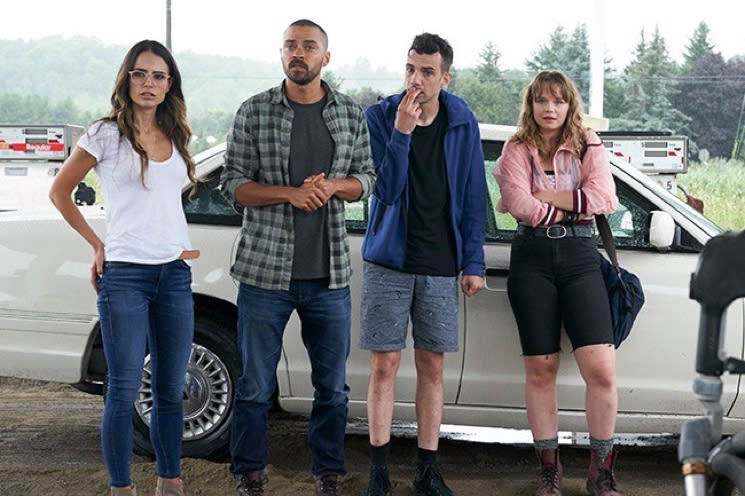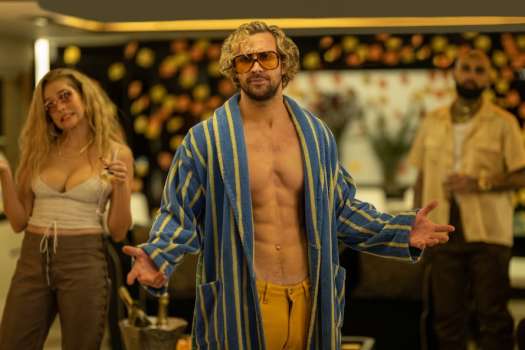At one time, the true crime that set me on edge were the paperbacks with a few glossy pages stuck in the middle, showing photos of the killers and the victims, in crime scenes or in casual settings. The poor taste was overwhelming, as real lives were made disposable twice — once in their end, and again for unseemly entertainment. Genres treading into violence are one thing; treating real lives with the same near-prurient approach felt different.
Random Acts of Violence is considering similar ethical quandaries. The Jay Baruchel-directed graphic novel adaptation features Jesse Williams as Todd, a comics creator fixated on a string of gruesome murders. He has turned that fascination into a fictionalized series that, eventually, bleeds into his real life, revealing the impact — personal and societal — of creative works that focus on grizzly violence.
Todd is bringing his title to an end, having found his artistic enthusiasm for his hulking serial killer, Slasherman, waning. Having made that decision, Todd can't figure out how the story should conclude, what punctuation he can place on a killer in a welder's mask arranging bodies in complex tableaus.
To find inspiration, he decides to travel to a comic-con down the I-90, the setting for the real string of killings that inspired his long-running work. Along for the ride are his pal and publisher Ezra (Baruchel) and assistant and aspiring artist (Niahm Wilson). His girlfriend Kathy (Jordana Brewster) is on the journey as well, working on a book focusing on the victims of the same killer Todd's series is inspired by.
The first stop along the way is a foreboding gas station, where all lighting comes from below and the attendant asks if the group has any meth. From there, events only go south, as scenes from the Slasherman series start to manifest in real crimes. The group frays as they cope with the possibility that the comic book is an impetus for the terrible events that surround them.
As the gang enters this section of the movie, the filmmaking details get more lurid. Scenes are bathed in the sickly yellows and greens that are contemporary horror staples. The sound design is pushed to a similar extreme, occasions of blood gushing or spurting or a person's gurgled cries being some of the most memorable aesthetic decisions here. Gruesome prosthetics and other practical details are well executed, more so than a few animated sequences or the examples of Todd's artistic work in the film, which feel threadbare.
The movie lines up with horror films of the last 15 or 20 years in significant ways, though it diverges in a few key areas. Todd is considering whether his work questions or contributes to a culture of violence. It doesn't take much to see that attitude reflected in the most violent scenes in the movie. These moments aren't particularly scary or suspenseful. At most, they're blunt, sometimes staying tight on the act, other times more than willing to hang back and watch from a distance.
At times, the film's approach can be read as ambivalent towards the pleasures of a serial killer film, while elsewhere, they give into the appeal of a bloody slaying. The argument is played out in dialogue between Todd and Kathy around what his work and what her victim-focused project each support, with other instances including a non-musical cameo by Alexisonfire's Wade McNeil as a radio interviewer. The points covered trend towards concerns about violence in the media familiar to the same line of thinking in the 1990s. Will representation lead to people emulating the bad acts?
The film's footing is surer when it relates to personal tolls and impacts, especially with regards to Todd and his connection to these events. Even that, though, is plagued by inconsistencies and nagging vagueries. Where did a cut on a hand come from? Are we even supposed to be asking that right then? Why is this person reacting this way? Is this person turned on or haunted?
Random Acts of Violence occasionally presents as a movie that could be at conflict itself, which could be fruitful or treacherous. The clash of ideas isn't explored deeply enough here, nor can the film live up to the promises of its genre entirely. Wherever violence is concerned, there should be thought and consideration as to how it's portrayed. This movie starts the work of considering its own approach in an interesting way without following it through completely.
Random Acts of Violence is considering similar ethical quandaries. The Jay Baruchel-directed graphic novel adaptation features Jesse Williams as Todd, a comics creator fixated on a string of gruesome murders. He has turned that fascination into a fictionalized series that, eventually, bleeds into his real life, revealing the impact — personal and societal — of creative works that focus on grizzly violence.
Todd is bringing his title to an end, having found his artistic enthusiasm for his hulking serial killer, Slasherman, waning. Having made that decision, Todd can't figure out how the story should conclude, what punctuation he can place on a killer in a welder's mask arranging bodies in complex tableaus.
To find inspiration, he decides to travel to a comic-con down the I-90, the setting for the real string of killings that inspired his long-running work. Along for the ride are his pal and publisher Ezra (Baruchel) and assistant and aspiring artist (Niahm Wilson). His girlfriend Kathy (Jordana Brewster) is on the journey as well, working on a book focusing on the victims of the same killer Todd's series is inspired by.
The first stop along the way is a foreboding gas station, where all lighting comes from below and the attendant asks if the group has any meth. From there, events only go south, as scenes from the Slasherman series start to manifest in real crimes. The group frays as they cope with the possibility that the comic book is an impetus for the terrible events that surround them.
As the gang enters this section of the movie, the filmmaking details get more lurid. Scenes are bathed in the sickly yellows and greens that are contemporary horror staples. The sound design is pushed to a similar extreme, occasions of blood gushing or spurting or a person's gurgled cries being some of the most memorable aesthetic decisions here. Gruesome prosthetics and other practical details are well executed, more so than a few animated sequences or the examples of Todd's artistic work in the film, which feel threadbare.
The movie lines up with horror films of the last 15 or 20 years in significant ways, though it diverges in a few key areas. Todd is considering whether his work questions or contributes to a culture of violence. It doesn't take much to see that attitude reflected in the most violent scenes in the movie. These moments aren't particularly scary or suspenseful. At most, they're blunt, sometimes staying tight on the act, other times more than willing to hang back and watch from a distance.
At times, the film's approach can be read as ambivalent towards the pleasures of a serial killer film, while elsewhere, they give into the appeal of a bloody slaying. The argument is played out in dialogue between Todd and Kathy around what his work and what her victim-focused project each support, with other instances including a non-musical cameo by Alexisonfire's Wade McNeil as a radio interviewer. The points covered trend towards concerns about violence in the media familiar to the same line of thinking in the 1990s. Will representation lead to people emulating the bad acts?
The film's footing is surer when it relates to personal tolls and impacts, especially with regards to Todd and his connection to these events. Even that, though, is plagued by inconsistencies and nagging vagueries. Where did a cut on a hand come from? Are we even supposed to be asking that right then? Why is this person reacting this way? Is this person turned on or haunted?
Random Acts of Violence occasionally presents as a movie that could be at conflict itself, which could be fruitful or treacherous. The clash of ideas isn't explored deeply enough here, nor can the film live up to the promises of its genre entirely. Wherever violence is concerned, there should be thought and consideration as to how it's portrayed. This movie starts the work of considering its own approach in an interesting way without following it through completely.




